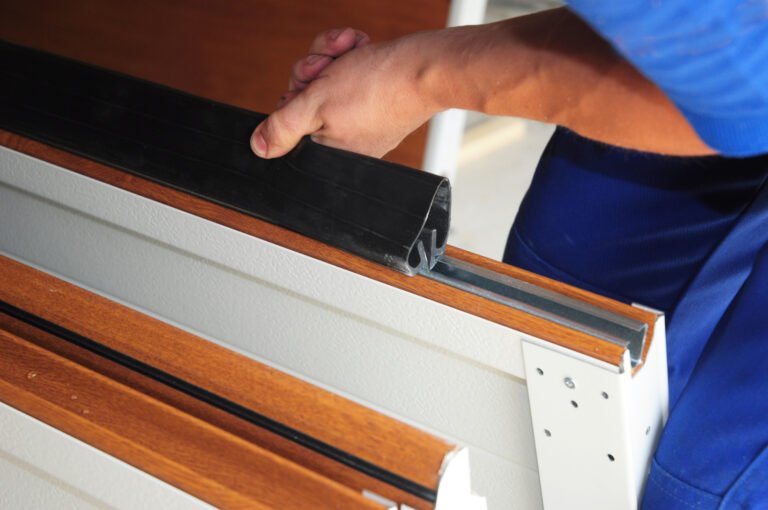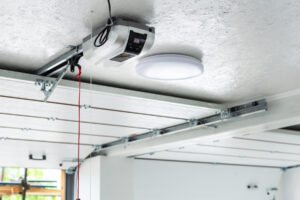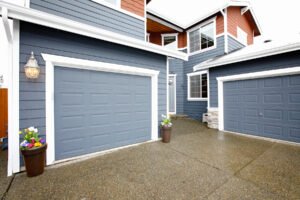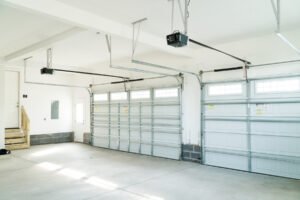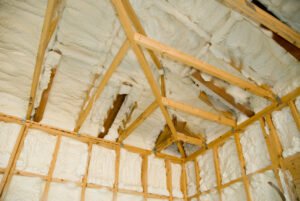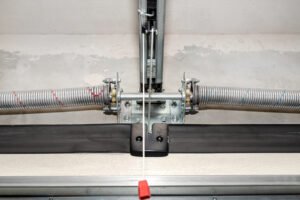Garages should be warm and functional. But have you ever found rodent droppings, stagnant rainwater, or debris beneath your threshold? Those small gaps between the door and the garage floor not only ruin your threshold but also let in the cool air that disrupts the insulation. And what’s worse than a cold, wet, and smelly garage, right?
So, if you are already irritated by those intruding roaches, reptiles, and rats in your garage, it’s high time you add a good-quality garage door seal. We’ll guide you through different types of garage door seals and explain all the pros, cons, and costs to help you choose wisely!
What Are Garage Door Seals?
A garage door bottom seal, also known as weatherstripping, astragal, or molding strip, is a self-sealing mechanism along all four edges of the garage door.
These strips mold as per the door’s bottom and create a tight seal that blocks the gap between the shutter and the floor, preventing moisture, dust, pests, and insects from entering and damaging your garage.
Types of Garage Door Seals Based on Installation
Garage door seals come in different sizes, adhesion, and installation methods and suit different types of garage doors according to their door tracks and shutter rollers.
So, we surveyed the market, picked the best bottom seal for each garage door, and listed their attributes to help you with your selection.
1. Garage Door Bottom Seal
What Is It: A garage door bottom seal is a flexible rubber or vinyl molding strip that sticks to the lower surface of the garage door, adapts to its shape, and creates a tight air seal that keeps the moisture and resistance at bay.
A garage door bottom seal is durable, affordable, and maintenance-free. It is directly nailed to the door or fits into a retainer channel that functions as a seal retainer and easily allows repair or replacement work.
Moreover, garage door bottom seals come in various designs, grooves, and installation methods that suit different garage door types. For instance, pick a strip-styled, angular-edged seal if you have a side-hinged, wooden garage door, while going with a U-shaped rubber seal for metal, aluminum sliding, or sectional doors.
| Average Lifespan | 10 – 12 years |
| Average Cost | $ 13 – 30 for a 20-foot strip |
| Best Used For | Protects from weather, cold air, and water stagnation |
Pros:
- Affordable and Easy to Install
- Creates a tight seal and provides good insulation
- Works with an overhead door, side-hinged door, and even a North Shore commercial door
Cons:
- Might shrink, crack, and lose its adhesion over time
- Might discolor due to continuous moisture contact
- Might expand or contract due to weather changes
- Comparatively weaker adhesion
Never use a petroleum or jelly-based lubricant on any garage door bottom seal as it might attract debris, lose its adhesion, and come out quickly.
2. J-Type Garage Door Bottom Seal
What Is It: J-type garage door bottom seals have angular grooves and slanted edges that form a J-section on both sides of the door and act as a storm shield that prevents heat loss and offers excellent weather protection.
J-type threshold seals are directly screwed onto the aluminum gasket of single-channel sliding or sectional doors and have a strip-like design that adapts to the floor line and seals the gap.
Here, you can use a flexible vinyl or rubber seal, or you can go with a sturdier aluminum bottom seal retainer with U-shaped rubber gaskets for more durability and easier installation. You can also mount J-seals on all four sides of your garage door for added insulation and protection.
| Average Lifespan | 7 – 15 years |
| Average Cost | $ 20 – 50 |
| Best Used For | Gap sealing and Insulation in Single-channel sliding doors |
Pros:
- Easy to Install, Repair, or Replace
- Can be mounted on the bottom and the sides
- Has a higher warranty
- Has reflective panels that prevent heat loss
Cons:
- Slightly expensive
- Irregular adhesion
- Lesser Durability and Lifespan
- Can tear and lose its elasticity with prolonged use
You can lubricate J-style garage door seals with wet lithium grease or good-quality silicone lubricant to maintain and enhance its elasticity in dry weather.
3. T Style Garage Door Bottom Seal
What Is It: A T-style garage door seal has a raised, inverted flange and a shallow horizontal web or support that fits into the gap between the shutter and the floor, creating an additional mound that keeps off pests.
T-style garage door seals are extremely easy to install and have small, U-shaped rubber gaskets that slide into the door’s tracks and seal the gaps efficiently. Moreover, these have a Steel, PVC, or Aluminum bottom seal retainer and can fit most residential and commercial garage doors’ top, bottom, and sides.
And just like the rest of the garage door seals, they prevent dust, water, and pests from entering inside but might wear off or rot with continuous exposure to water. Hence, they are more suitable for garages in sloping or arid areas.
| Average Lifespan | 5 – 10 years |
| Average Cost | $ 10 – 15 |
| Best Used For | Pest and Dust control, Excellent Garage Door Insulation |
Pros:
- Easy to Slide and Replace
- Affordable and Lesser maintenance charges
- Come in various sizes and colors
- Suits single and double-channeled retainers
Cons:
- Might degrade with moisture
- No self-adhesion and requires nailing
- Too thin and might tear
Pick 3-4” thick T seals for standard, Wayne Dalton or North shore commercial doors and choose slightly thinner, 2 ½” sections for standard residential doors.
4. Bulb Seals
What Is It: Bulb seals are slender tapering tubes with a flexible, curved head and an elastic molding strip that compresses and spreads out over uneven garage floors.
Bulb seals are long and tubular, sealing out all the gaps from uneven floors and bulging out from the openings. These are pretty seamless and concealed but require a sturdy seal retainer or pads to resist moisture and last longer.
Nevertheless, these seals are the right tap to secure any roller, sectional or overhead door and prevent rust and corrosion extensively.
Moreover, these seals are available in various bulb-heads and sizes, and you can use a tear-drop-shaped bulb seal to keep off pests and resist moisture or pick a regular, half-moon bulb seal to insulate from the cold air and noise.
| Average Lifespan | 10 – 12 years |
| Average Cost | $ 20 – 50 |
| Best Used For | Moisture and Dust Control in rolling or overhead door |
Pros:
- Extremely flexible and secures any uneven concrete floor
- Better dust and water resistance
- Long-lasting and low-maintenance
- Can be reinforced with steel cores or wires for better water resistance
Cons:
- Might not be effective against sound
- Create a tight air seal and may require air conditioning inside
- Can misalign and lose its flexibility over time
Never use a bulb seal with any 90° gaskets or channels as it might bend, warp and leak eventually.
5. Beaded Seals
What Is It: Beaded seals are double-channeled garage door threshold seals with circular grooves and bent sides that eliminate water flow into the garage.
A beaded seal is strong, sturdy, and closes any bigger gaps under and around your garage doors. These are great in snowy regions and do not split, crack or warp up to about 30° F.
Moreover, this type of bottom seal fits onto uneven floors and sloping sites and keeps your garage’s moisture in check. Plus, these are flexible, non-toxic, and have a durable, high-grade rubber top coat.
| Average Lifespan | 10 – 15 years |
| Average Cost | $ 20 – 40 |
| Best Used For | Moisture and Snow Control in sloping garages |
Pros:
- Sturdy and withstands extreme temperature changes
- Easy installation and maintenance
- Keeps garages warm and sound-proof
Cons:
- Might not be that suitable for smaller gaps or polished floors
- Low adhesion and requires nailing
- Might not be that effective on the sides or top of the garage door
Apply a good-quality, specialized silicone WD-40 lubricant to protect the rubber seal from dust and moisture, and add a sturdier Aluminum bottom seal retainer to help it last longer.
6. Brush Seals or Weatherstripping
What Is It: A brush seal or weather strip is a bend and flex brush attached to a molding strip that secures the door from high friction and keeps dust and debris away.
Brush seals or brush sweep seals are durable, anti-dust seals used for high-use, automatically operated residential or commercial doors. Though they don’t very well resist water and snow, they withstand extreme heat, sand, and humidity and are the right tap for coastal or West Bay garages.
Plus, these create a tight garage door weather seal at the threshold and can be effectively used for the door sides and door tops as well. They compress and create recessions to fit different garage door hinges at the sides and do not require much cutting or drilling.
| Average Lifespan | 15 – 20 years |
| Average Cost | $ 5 – 20 |
| Best Used For | Dust and Debris control in sandy areas |
Pros:
- Can resist extreme heat or cold
- Can be mounted to fit many angles and spaces
- Fits both smaller and larger door gaps
- Extremely easy to install and replace
- Affordable
Cons:
- Needs an additional insect mesh to keep pests away
- Have a self-backed tape that might lose its adhesion
- Drags the threshold debris to the driveway and might make it dirty
Install your brush seal to the inward edge if you have a rolling or overhead door, and mount it on the outer edge if you have side-hinged or swing-out doors. This way, you’ll eliminate dust from your garage and help reduce friction.
7. Garage Door Threshold Seal
What Is It: A threshold seal is nothing but a thick, insulated rubber or vinyl strip that sticks directly to the garage floor and blocks surface water or snow that might seep into the garage from the ground.
A garage door threshold seal is durable, affordable, and long-lasting. It suits steep or uneven driveways and effectively blocks all the rainwater from entering your garage. But, it doesn’t protect from dust and pests and needs an additional bottom seal at the top for complete insulation. Nonetheless, it blocks all the larger gaps and prevents any fungal ingress.
However, remember that a garage door threshold seal will make it difficult to push water and sweep dust out of a garage, making it tedious to clean. In contrast, it doesn’t need to be installed or removed now and then and speeds up any garage door repair work.
| Average Lifespan | 5 – 6 years |
| Average Cost | $ 30 – 40 |
| Best Used For | Water and Dust Insulation |
Pros:
- Works on both even and undulated land
- Suits both residential or commercial doors with automated garage door openers
- Has a glowing yellow strip that makes it easier to see in the dark
Cons:
- Needs an additional bottom seal for weather and pest insulation
- Difficult to clean and maintain
- Doesn’t seal the sides and the top
You can add a silicone or latex-based caulk to protect your threshold seal from extreme weather changes, sun damage, and temperature and enhance its durability.
8. Door Stop Weatherstripping
What Is It: A door stop weather seal is a packaged rubber or vinyl roll with a self-insulating top coat that sticks to the door jambs and allows additional insulation to the door and garage ceiling.
Garage door weather strips stick to the top and sides of the garage door and have flexible molding that adapts to the gaps and insulates against the weather. These come in rolls and can be easily cut with a utility knife and screwed to the surface.
Moreover, these have an additional galvanized metal film at the sides that retains heat and creates a tight seal.
| Average Lifespan | 5 – 7 years |
| Average Cost | $ 5 – 20 |
| Best Used For | Air and Heat Insulation |
Pros:
- Easiest to Install and Repair
- Keeps pests away
- Can be customized as per door size and thickness
Cons:
- Might warp due to excess moisture
- Might not last longer
- It discolors and deforms with continuous use
Wash the weather seal with a non-abrasive soap or shampoo at least once a week and wipe it with silicone to prevent the rubber from drying.
9. Panel Weatherstripping
What It Is: Panel weather strips are V-shaped, foam-filled, rubber molding strips that stick onto the folding panels of sectional doors and create a water-tight seal according to the door panels.
Panel strips are thin and lightweight and seal the gaps between individual door panels. These have a flexible, flat-shaped construction with a solid self-adhesive and interlocking mechanism that compresses into smaller holes and creates a tight seal.
Moreover, these seals are sold as rolls. So, you can simply cut it according to your door’s length and slide it inside.
| Average Lifespan | 10 – 12 years |
| Average Cost | $ 10 – 20 |
| Best Used For | Weather, Dust, and Heat Insulation |
Pros:
- Seals from all sides and prevent heat loss
- Inexpensive but durable
- Strong self-adhesion
Cons:
- Likely to break and deform with heavy door use
- Tricky to slide into smaller gaps
- Limited to a 25mm gap
Spray some non-flammable spray brake cleaner onto the surface of your sectional doors to prevent the weatherstrip from freezing and jamming the door.
Comparison Between Popular Garage Door Seals
| Parameter | Bottom | J-Type | T-Type | Bulb | Beaded | Brush | Threshold | Doorstop | Panel |
| Durability | High | High | Low | High | High | High | Low | Low | Moderate |
| Cost | Moderate | High | Low | High | High | Low | High | Low | Moderate |
| Insulation | Air | Air | Dust | Water | Water | Dust | Water | Heat | Dust |
| Seal Retainer | No | Yes | Yes | Yes | No | No | No | No | No |
| Ease of Installation | Moderate | High | High | Moderate | Moderate | Easy | Moderate | Easy | Moderate |
Types of Garage Door Seals Based on Materials
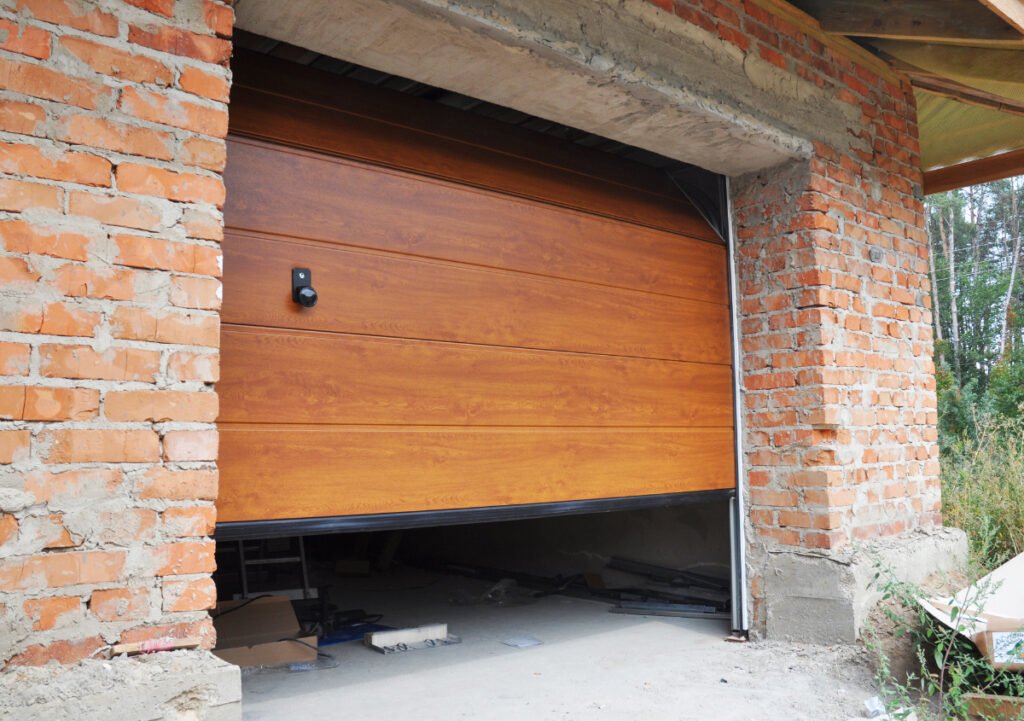
Generally, garage door seals are made of vinyl and rubber. There may be aluminum or metal retainers at the top, but they also have a flexible rubber or vinyl weather strip for necessary insulation and heat retention.
But what is the best garage door seal material – Rubber or Vinyl? Let’s find out.
10. Rubber Seal
Rubber seals are incredibly flexible and lightweight and easily conform to abstract shapes and smaller gaps. In addition, these have high-adhesion back tape and don’t require any screwing or drilling for installation.
Plus, these last for about 15-20 years and can be easily cut, compressed, and customized according to your door size.
11. Vinyl Seal
A vinyl garage door seal is sturdier and durable but comes in pre-cast sets, rolls, and molding strips that allow a speedy installation but cannot be molded as per the door width.
However, these are sturdier and create a garage spring-like action that helps operate the door. Plus, it can be drilled on the internal and external door surfaces and helps retain heat.
| Rubber Door Bottom Seal | Vinyl Door Bottom Seal |
| Expands & Contracts with Temperature | DOES NOT expand or contract & is much sturdier |
| Back Adhesion, and NO SCREWING | Might need screws and additional fastening devices |
| Lasts for about 12 – 15 years | Lasts for about 15 – 20 years |
| Lesser product choices but more flexible | More pre-cast options and product choices |
| Crude, Industrial look | Polished, Modern, and Contemporary Look |
| Easily visible and Quite thicker | Thinner and can be concealed |
Benefits of Garage Door Bottom Seals
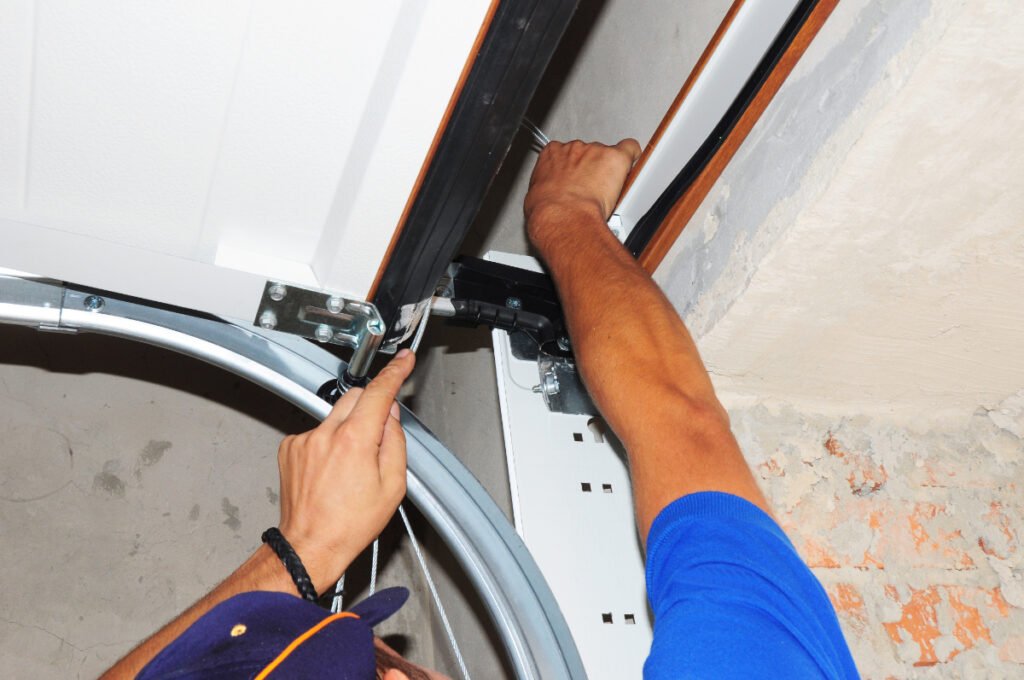
If you think garage door bottom seals are just to seal all those tiny air gaps and insulate your garage door, you’re wrong! They have many other benefits!
- Weather Insulation: Garage door bottom seals create a tight seal and bring down the heating and cooling costs, thus saving energy bills.
- Protect the Door: Larger garage doors are often roughly handled and might bang straight down to the floor below. The seal adds a soft cushioning around the door in such cases and prevents direct wear and tear.
- Eliminates Pests: Garage door seals block the gaps between the shutter and the floor, restricting cockroaches, geckoes, and mice from sneaking inside.
Do Garage Door Seals Shrink?
Yes, garage door seals shrink over time, especially with continual exposure to moisture, temperature changes, and snow. In such cases, you may coat the surface with wax or silicone grease to prevent further shrinking or massage some vegetable oil onto its surface. However, replace the seal immediately if there’s a 3-4” gap between the seal and the floor.
Do Garage Door Seals Come in Different Sizes?
Yes, garage door seals come in varying widths of 3 – 4”, but they may be customized to fit slender doors up to 2 ½ inches thick. Plus, they are about 8 – 20 feet long with 1-foot sections that can be easily expanded to fit odd-sized doors.
How Often Should You Replace the Garage Door Seal?
Garage door seals are long-lasting and might last for about 15-20 years with proper maintenance. However, you should lubricate them twice a month and replace them if they lose their elasticity, deform, warp, or discolor.
How Much Does It Cost to Replace Garage Door Seals?
Garage door seal replacement costs about $90 – 100 for the bottom seal, $85 – 130 for the side seals, and $200 for replacing the seal from all four sides.
Garage door bottom seals insulate your garage from unwanted guests like water, sound, dust, cold, and rodents and help maintain a clean, cozy space. Plus, they reduce your energy bill by about 10-15% and single-handedly offer all the benefits of air purifiers, conditioners, and insect nets.
Now that you have closed all those minor gaps between your garage door panels and the floor, you can finally paint your garage door your favorite color. You can get it done by professionals or DIY using our easy guide on painting garage doors!

